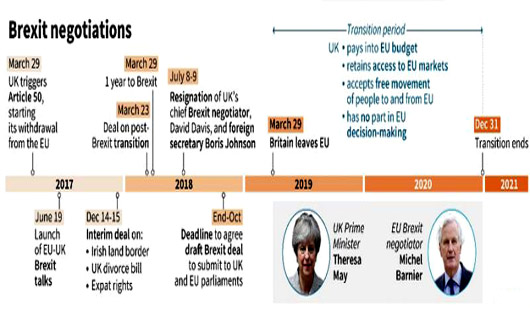SALZBURG, Austria, Sept 20, 2018 (BSS/AFP) – EU leaders will on Thursday
make preparations for the final stretch of Brexit negotiations, after
clashing with Britain over how to bridge their differences to reach a divorce
deal.
Leaders of the 27 other European Union countries will meet without British
Prime Minister Theresa May in Salzburg, during the first of three summits in
successive months that Brussels hopes will yield an agreement.
But as they arrived for a pre-summit dinner in the Austrian city on
Wednesday evening, both sides called on the other to make further
concessions.
EU Council President Donald Tusk said that despite progress in some areas,
on the two thorniest issues of the Irish border and post-Brexit trade ties,
“the UK’s proposals will need to be reworked”.
May, who is under intense pressure from Brexiteers back home, retorted
that she had already made compromises and it was now the turn of Brussels.
“If we are going to achieve a successful conclusion then, just as the UK
has evolved its position, the EU will need to evolve its position too,” she
said.
Both sides had been aiming for an October EU summit as the deadline to
reach an agreement, to allow time for the deal to be ratified by British and
European parliaments before Brexit in March.
But with the talks deadlocked, Tusk is seeking approval on Thursday for
another summit in November — when he warned there must be a deal, to avert a
“catastrophe” of Britain crashing out of the bloc.
– ‘Get this deal done’ –
The summit dinner was dominated by discussions over how to deal with
irregular migration into Europe, but May gave a short speech on Brexit at the
end, officials said.
She pressed her case for a Brexit deal, telling fellow leaders: “The onus
is now on all of us to get this deal done.” For the first time, she presented
to the group her so-called Chequers plan for the post-Brexit trading
relationship, which was published in July.
Her proposal to follow EU rules on trade in goods has provoked a fierce
backlash among eurosceptics in her Conservative party, renewing speculation
of a challenge to her leadership.
EU chief negotiator Michel Barnier has also been deeply critical of the
plan, which May hopes could form the basis of a political agreement on trade
to be included in the divorce deal.
British officials insist however that it is the only way to protect
existing trade after Brexit while also resolving the Irish issue.
– Irish border talks –
Much of the divorce deal is agreed, but a key sticking point is how to
avoid a “hard border” between British-ruled Northern Ireland and the Irish
Republic when London leaves the EU single market and customs union.
There are fears that frontier checks would disrupt trade and could
undermine the 1998 peace deal on the island.
Europe is insisting on a fall-back plan, a “backstop”, that would keep
Northern Ireland in the customs union under EU rules while a future trade
relationship is negotiated.
London has rejected this, saying it would create a border in the Irish Sea
that threatens its territorial integrity, but offered only a partial proposal
in return.
May will meet with Irish Premier Leo Varadkar before the Brexit talks on
Thursday, and Tusk will brief her afterwards on what the EU27 discussed.
Diplomats warned before Salzburg that there would be little headway as
both sides act cautiously before May’s Conservatives begin their annual
conference on September 30.
But there were signs of some movement on Ireland, after Barnier suggested
any checks between Northern Ireland and the rest of the UK could be away from
the border.
May welcomed his willingness to “find a new solution”, and conceded that
some checks were already carried out in the Irish Sea, on agricultural
products.
But she repeated her warning that Britain would not agree to a “legal
separation of the United Kingdom into two customs territories”.



